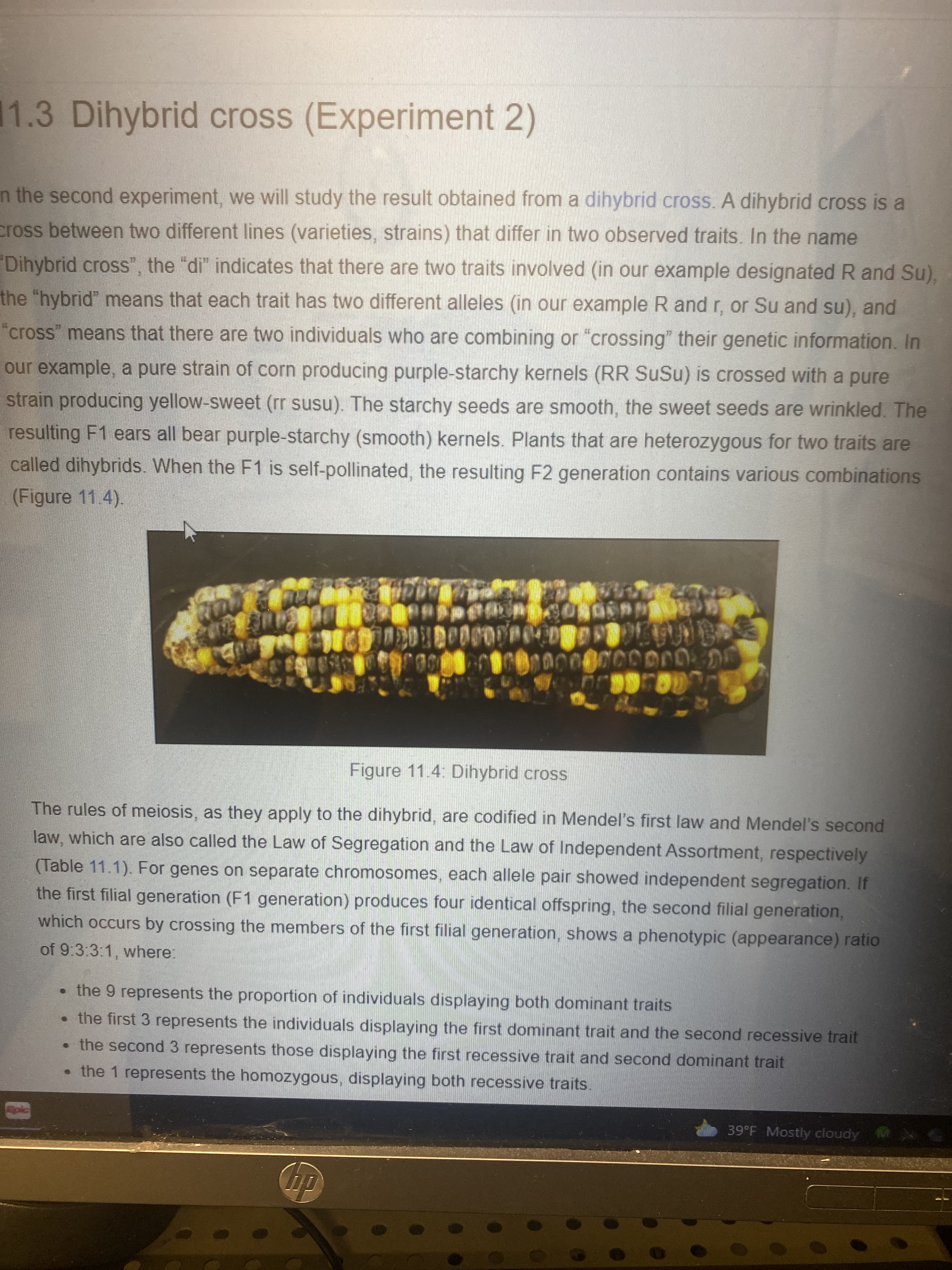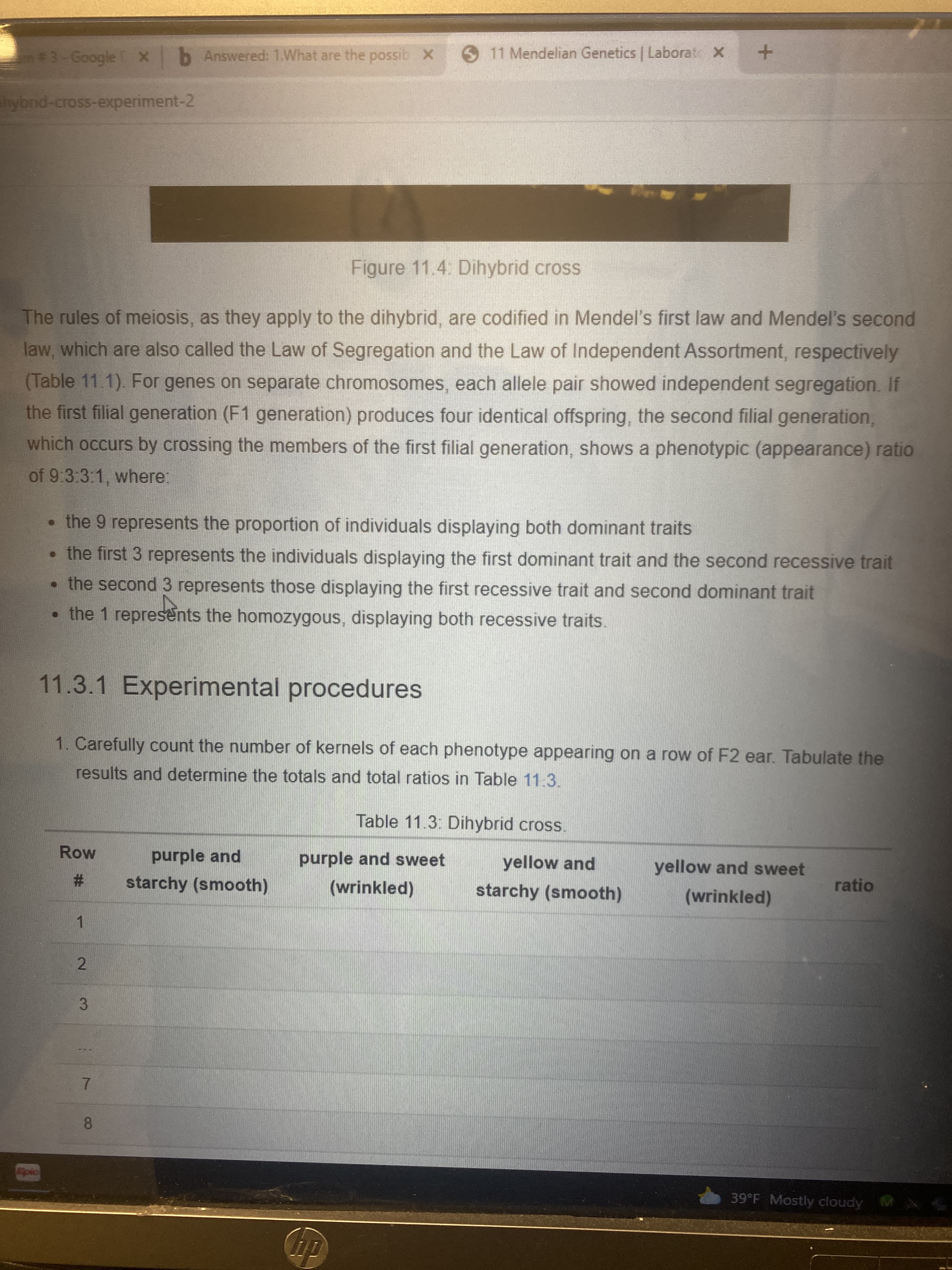What is the genotype of the F1 generation of the corn dihybrid cross described above? What is the phenotype of the F1 generation of the corn dihybrid cross described above? What are
What is the genotype of the F1 generation of the corn dihybrid cross described above? What is the phenotype of the F1 generation of the corn dihybrid cross described above? What are
Human Anatomy & Physiology (11th Edition)
11th Edition
ISBN:9780134580999
Author:Elaine N. Marieb, Katja N. Hoehn
Publisher:Elaine N. Marieb, Katja N. Hoehn
Chapter1: The Human Body: An Orientation
Section: Chapter Questions
Problem 1RQ: The correct sequence of levels forming the structural hierarchy is A. (a) organ, organ system,...
Related questions
Question
- What is the genotype of the F1 generation of the corn dihybrid cross described above?
- What is the
phenotype of the F1 generation of the corn dihybrid cross described above? - What are the possible maternal and paternal genotypes of the F1 gametes of the corn dihybrid cross described above?

Transcribed Image Text:1.3 Dihybrid cross (Experiment 2)
n the second experiment, we will study the result obtained from a dihybrid cross. A dihybrid cross is a
cross between two different lines (varieties, strains) that differ in two observed traits. In the name
Dihybrid cross", the "di" indicates that there are two traits involved (in our example designated R and Su),
the "hybrid" means that each trait has two different alleles (in our example R and r, or Su and su), and
"cross" means that there are two individuals who are combining or "crossing" their genetic information. In
our example, a pure strain of corn producing purple-starchy kernels (RR SuSu) is crossed with a pure
strain producing yellow-sweet (rr susu). The starchy seeds are smooth, the sweet seeds are wrinkled. The
resulting F1 ears all bear purple-starchy (smooth) kernels. Plants that are heterozygous for two traits are
called dihybrids. When the F1 is self-pollinated, the resulting F2 generation contains various combinations
(Figure 11.4).
Figure 11.4: Dihybrid cross
The rules of meiosis, as they apply to the dihybrid, are codified in Mendel's first law and Mendel's second
law, which are also called the Law of Segregation and the Law of Independent Assortment, respectively
(Table 11.1). For genes on separate chromosomes, each allele pair showed independent segregation. If
the first filial generation (F1 generation) produces four identical offspring, the second filial generation,
which occurs by crossing the members of the first filial generation, shows a phenotypic (appearance) ratio
of 9:3:3:1, where:
• the 9 represents the proportion of individuals displaying both dominant traits
• the first 3 represents the individuals displaying the first dominant trait and the second recessive trait
• the second 3 represents those displaying the first recessive trait and second dominant trait
• the 1 represents the homozygous, displaying both recessive traits.
39°F Mostly cloudy M

Transcribed Image Text:%23
3.
b Answered: 1.What are the possib X 11 Mendelian Genetics | Laborato X
hybrid-cross-experiment-2
Figure 11.4: Dihybrid cross
The rules of meiosis, as they apply to the dihybrid, are codified in Mendel's first law and Mendel's second
law, which are also called the Law of Segregation and the Law of Independent Assortment, respectively
(Table 11.1). For genes on separate chromosomes, each allele pair showed independent segregation. If
the first filial generation (F1 generation) produces four identical offspring, the second filial generation,
which occurs by crossing the members of the first filial generation, shows a phenotypic (appearance) ratio
of 9:3:3:1, where:
• the 9 represents the proportion of individuals displaying both dominant traits
•the first 3 represents the individuals displaying the first dominant trait and the second recessive trait
• the second 3 represents those displaying the first recessive trait and second dominant trait
• the 1 represents the homozygous, displaying both recessive traits.
11.3.1 Experimental procedures
1. Carefully count the number of kernels of each phenotype appearing on a row of F2 ear. Tabulate the
results and determine the totals and total ratios in Table 11:3.
Table 11.3: Dihybrid cross.
Row
purple and
purple and sweet
yellow and
yellow and sweet
ratio
#3
starchy (smooth)
(wrinkled)
starchy (smooth)
(wrinkled)
1.
2.
7.
8.
39°F Mostly cloudy M
Expert Solution
This question has been solved!
Explore an expertly crafted, step-by-step solution for a thorough understanding of key concepts.
This is a popular solution!
Trending now
This is a popular solution!
Step by step
Solved in 2 steps

Recommended textbooks for you

Human Anatomy & Physiology (11th Edition)
Anatomy and Physiology
ISBN:
9780134580999
Author:
Elaine N. Marieb, Katja N. Hoehn
Publisher:
PEARSON

Anatomy & Physiology
Anatomy and Physiology
ISBN:
9781259398629
Author:
McKinley, Michael P., O'loughlin, Valerie Dean, Bidle, Theresa Stouter
Publisher:
Mcgraw Hill Education,

Human Anatomy
Anatomy and Physiology
ISBN:
9780135168059
Author:
Marieb, Elaine Nicpon, Brady, Patricia, Mallatt, Jon
Publisher:
Pearson Education, Inc.,

Human Anatomy & Physiology (11th Edition)
Anatomy and Physiology
ISBN:
9780134580999
Author:
Elaine N. Marieb, Katja N. Hoehn
Publisher:
PEARSON

Anatomy & Physiology
Anatomy and Physiology
ISBN:
9781259398629
Author:
McKinley, Michael P., O'loughlin, Valerie Dean, Bidle, Theresa Stouter
Publisher:
Mcgraw Hill Education,

Human Anatomy
Anatomy and Physiology
ISBN:
9780135168059
Author:
Marieb, Elaine Nicpon, Brady, Patricia, Mallatt, Jon
Publisher:
Pearson Education, Inc.,

Anatomy & Physiology: An Integrative Approach
Anatomy and Physiology
ISBN:
9780078024283
Author:
Michael McKinley Dr., Valerie O'Loughlin, Theresa Bidle
Publisher:
McGraw-Hill Education

Human Anatomy & Physiology (Marieb, Human Anatomy…
Anatomy and Physiology
ISBN:
9780321927040
Author:
Elaine N. Marieb, Katja Hoehn
Publisher:
PEARSON